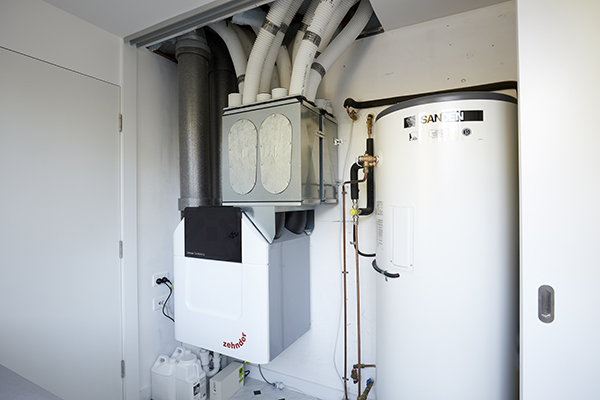Just How Heat Recovery Ventilation Enhances Indoor Air High Quality and Reduces Energy Prices
Heat Recovery Ventilation (HRV) systems play a crucial role in boosting indoor air quality while simultaneously decreasing energy expenses. By efficiently exchanging stagnant indoor air with fresh outdoor air, HRVs aid preserve optimal moisture and decrease toxins. Furthermore, their capacity to recoup heat from outbound air lessens the pressure on heating and cooling down systems. As power costs continue to increase, understanding the full possibility of HRV systems comes to be increasingly crucial for home owners and companies alike.
Recognizing Heat Recovery Ventilation Systems

Heat recovery ventilation (HRV) systems play a crucial function in boosting interior air quality, especially in modern-day, energy-efficient structures. These systems are designed to move heat from the outbound stagnant air to the inbound fresh air, thus minimizing energy loss while maintaining ideal temperature level degrees inside your home. HRVs include a warmth exchanger, fans, and ductwork, helping with the continual circulation of air. By removing interior pollutants and introducing fresh air, HRVs aid to balance humidity degrees, stop mold and mildew growth, and lower irritants. The efficiency of HRV systems exists in their ability to recoup approximately 80% of the warm from the tired air, promoting energy conservation while making sure a healthy and balanced indoor environment. Their integration is important in attaining lasting living techniques.
The Value of Indoor Air Top Quality
Indoor air quality (IAQ) is an important aspect influencing the health and health of passengers in any type of setting. Poor IAQ can result in various wellness problems, including respiratory problems, allergic reactions, and exhaustion. In addition, it can intensify status quo such as asthma. Factors adding to reduced IAQ consist of toxins from indoor resources like cleaning representatives, mold, and inadequate ventilation. Preserving excellent IAQ is important for advertising a safe and comfortable living or working space. Efficient approaches to improve IAQ include normal monitoring of air quality, correct ventilation systems, and decreasing the use of harmful materials indoors. By prioritizing IAQ, people can guarantee a much healthier environment that promotes performance and total high quality of life.
Energy Performance Conveniences of HRV Equipments
Many homeowners and building managers are significantly identifying the power effectiveness advantages of warm recuperation air flow (HRV) systems. By moving warm from worn down interior air to inbound fresh air, HRV systems substantially decrease the power required for heating & cooling. This procedure reduces reliance on typical HVAC systems, leading to lower power costs. Furthermore, HRVs help keep a balanced indoor climate, protecting against extreme home heating or cooling needs. The capability to recover as much as 90% of the heat from outbound air also supports sustainability efforts by reducing overall energy intake. Subsequently, HRV systems add not only to cost financial savings but additionally to a minimized carbon impact, lining up with the expanding emphasis on energy-efficient building techniques.
Installment and Upkeep Considerations
The effective application of warmth recovery ventilation (HRV) systems calls for careful factor to consider of installation and upkeep variables to assure peak performance. Appropriate positioning of the HRV device is vital, as it ought to be mounted in a location that makes best use of airflow while decreasing sound interruption. In addition, ductwork should be properly sized and protected to avoid energy loss. Regular maintenance, consisting of filter substitute and system cleaning, is essential to secure optimal functionality and indoor air high quality. Proprietors must establish a regular maintenance routine to determine and attend to prospective issues before they escalate. Partnership with skilled professionals during both installation and maintenance phases can enhance the longevity and effectiveness of HRV systems, eventually causing far better interior atmospheres and minimized power expenses.
Real-World Applications and Success Stories
Discovering real-world applications of warm healing ventilation (HRV) systems reveals their significant influence on interior air top quality and energy efficiency throughout numerous setups. In domestic buildings, homeowners have actually reported better air high quality, leading to fewer allergies and respiratory concerns. Schools applying HRV systems have actually kept in mind improved student concentration and reduced absenteeism because of better ventilation. Business buildings, such as workplaces and retail areas, have experienced reduced energy costs and boosted employee productivity. A business workplace in a warm environment accomplished a 30% reduction in power expenses after mounting an HRV system. These success stories show that HRV technology not only adds to much healthier settings however additionally offers substantial financial benefits, making it a valuable financial investment for various fields.
Often Asked Inquiries
Can HRV Systems Decrease Irritants in Indoor Air?
The efficiency of HRV systems in reducing indoor irritants primarily hinges on their capability to filter and exchange air. HRV Heat Recovery Ventilation. By continuously replacing stagnant air, these systems can greatly lower irritant degrees throughout indoor settings

Exactly How Does Moisture Affect HRV System Performance?
Moisture greatly affects HRV system efficiency; high levels can result in condensation, minimizing performance, while reduced moisture might enhance air exchange. Balancing moisture is crucial for optimal procedure and keeping indoor air quality.
Are HRV Solutions Noisy During Procedure?
HRV systems can generate varying HRV Heat Recovery Ventilation noise levels during operation, depending upon their style and installment. Some devices run silently, while others might generate visible sound, specifically at greater air flow setups or when inadequately kept.
What Is the Average Lifespan of an HRV System?

Can HRV Equipments Be Utilized in All Climates?
HRV systems can be utilized in numerous climates, but their effectiveness may vary - HRV Heat Recovery Ventilation. In severe temperature levels, adjustments or supplemental systems may be needed to assure optimal efficiency and convenience while preserving indoor air top quality